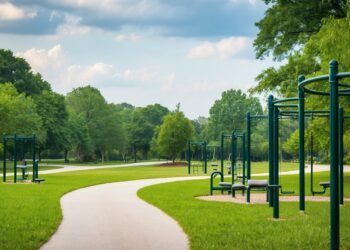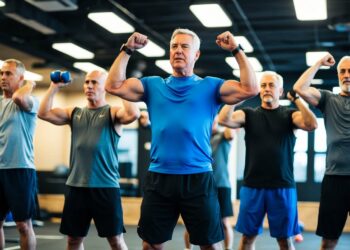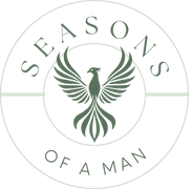Feeling stressed? You’re not alone. Many men over 50 face daily pressures that can take a toll on both mental and physical health.
As we age, finding effective ways to manage stress becomes even more important for our overall well-being.
Exercise is one of the most powerful stress relievers available to men over 50. Studies show it can reduce depression, lower cortisol levels, and improve cognitive function.
Whether it’s a brisk walk, swimming, yoga, or tai chi, moving our bodies creates positive changes in our brain chemistry.
Light to moderate activities are particularly effective. Practices like qigong show consistent stress-reduction benefits.
We believe healthy aging involves caring for both body and mind.
Regular physical activity not only helps manage stress but also improves quality of life as we navigate our 50s and beyond.
Even if you have physical limitations, talking with your doctor can help find exercises that work for your specific needs and health goals.
Understanding Stress and the Aging Process
As we age, our bodies respond to stress differently than they did in our younger years. The relationship between stress and aging is complex, with each influencing the other in ways that can significantly impact overall health and quality of life for men over 50.
The Impact of Stress on Older Adults
Stress affects older adults differently than younger people. Our bodies produce more stress hormones as we age, while our ability to recover from stress decreases.
This can lead to more pronounced physical effects like increased blood pressure and a higher risk of heart disease.
Chronic stress in men over 50 is linked to accelerated cognitive decline and may increase the risk of dementia. It can also worsen existing health conditions like diabetes and arthritis that are common in this age group.
Depression and anxiety often accompany high stress levels, creating a cycle that’s hard to break. Studies show that older adults who experience prolonged stress face higher mortality risks and a shorter life expectancy.
The good news? Physical activity helps our bodies manage stress hormones better, reducing their negative impact on our health.
Common Stressors for Men Over 50
Men over 50 face unique stressors that younger men might not experience. Retirement brings financial concerns and identity shifts that can be deeply unsettling. Many men struggle with this transition from career to retirement.
Health changes become more prominent, with new diagnoses or worsening chronic diseases creating worry and frustration. Watching our bodies change can affect self-image and confidence.
Relationship dynamics shift as children leave home or partners face their own health challenges. Many men become caregivers for aging parents or spouses, adding significant stress.
Social connections often diminish as friends move away or pass on. This isolation can intensify feelings of stress and anxiety.
Technology changes and feeling “left behind” in a rapidly evolving world create another layer of stress unique to older generations.
The Role of Exercise in Stress Management
Exercise offers powerful benefits for managing stress in men over 50. Regular physical activity helps our bodies process stress hormones while improving mood and overall well-being.
Types of Stress-Relieving Exercises
Aerobic activities like walking, swimming, and cycling are excellent choices for stress relief. These exercises increase heart rate and release endorphins that naturally boost mood.
Strength training with weights or resistance bands helps reduce stress by focusing the mind and building confidence. Aim for 2-3 sessions per week.
Mind-body exercises deserve special attention:
- Yoga combines movement with breathing
- Tai chi offers gentle flowing movements
- Stretching reduces muscle tension
We find that mixing different exercise types works best. A balanced routine might include 30 minutes of walking five days a week plus two strength sessions.
The key is finding activities you enjoy. Fun exercises are more likely to become habits that stick around for the long term.
The Science Behind Exercise and Stress Relief
When we exercise, our bodies reduce levels of stress hormones like cortisol while increasing endorphins—natural mood elevators. This chemical shift helps explain why we feel better after activity.
Regular exercise also improves sleep quality, which directly impacts our stress levels. Better sleep means better stress management the next day.
Physical activity also creates positive changes in our brains. Exercise increases blood flow to the brain and promotes growth of new neural connections, improving our mental focus and clarity.
Research confirms these benefits aren’t just temporary. Studies show that men over 50 who exercise regularly report lower overall stress levels, improved mental health, and better quality of life.
Exercise helps lower blood pressure too, reducing the risk of heart disease—a significant concern for our age group. Even moderate activity like brisk walking provides these health benefits.
Designing a Sustainable Exercise Routine
Creating an exercise routine that sticks requires thoughtful planning and realistic expectations. A good fitness plan should fit your lifestyle, address your specific needs, and be enjoyable enough to maintain long-term.
Overcoming Barriers to Regular Exercise
Many men over 50 face common obstacles when starting an exercise routine. Time constraints, physical limitations, and lack of motivation can all get in the way.
Start by identifying your personal barriers. Are you too tired after work? Schedule workouts for mornings. Do joint problems make exercise painful? Try low-impact activities like swimming or cycling.
Finding an exercise buddy can make a huge difference. We’ve seen that men who work out with friends stick with their routines longer. It adds accountability and makes the experience more enjoyable.
Don’t let self-consciousness stop you. Remember, everyone at the gym is focused on their own workout, not judging yours.
Start small with short, 10-minute sessions of moderate-intensity aerobic activity. Even brief walks count toward your physical activity guidelines.
Setting Realistic Fitness Goals
The most sustainable exercise plans begin with achievable targets. Rather than aiming to “get in shape,” set specific, measurable goals like “walk for 20 minutes three times a week.”
Track your progress using a fitness app or simple notebook. This helps you see improvements and stay motivated when things get tough.
Mix different types of exercise for best results:
- Aerobic activity: 150 minutes of moderate-intensity (brisk walking) or 75 minutes of vigorous-intensity activity (jogging) weekly
- Muscle-strengthening: 2-3 sessions of resistance training or weight training per week
- Flexibility exercises: Daily stretching to maintain mobility
Remember that recovery is crucial. We need more rest days as we age, so plan at least 48 hours between strength workouts for the same muscle groups.
Celebrate small wins! Each step toward a more active lifestyle deserves recognition.
Special Considerations for Men Over 50
As we age, our bodies change and require different approaches to exercise. Men over 50 need to be mindful of these changes to stay active while protecting their health.
Adapting Exercises for Physical Limitations
Joint pain and arthritis become more common after 50. We recommend low-impact activities like swimming, cycling, or walking that are easier on your joints while still providing excellent cardiovascular benefits.
Balance exercises are crucial as we age. Tai Chi is particularly effective for improving balance and reducing fall risk. Even simple practices like standing on one foot while brushing your teeth can help maintain functional capacity.
For those with existing medical conditions, working with a physical therapist can help create a customized exercise plan. They can suggest modifications that accommodate limitations while still providing benefits.
Strength training should focus on proper form rather than heavy weights. Using resistance bands or bodyweight exercises can build muscle strength with less strain on joints.
Exercise Safety and Injury Prevention
Always start with a proper warm-up. Spend 5-10 minutes doing light activity to prepare your muscles and reduce injury risk.
Listen to your body. Pain is different from the normal discomfort of a good workout. Stop if you experience sharp or sudden pain.
Recovery time becomes more important after 50. We need more rest between intense workouts. So, plan for at least one full rest day between strength training sessions for the same muscle groups.
Sleep and exercise have a beneficial relationship. Regular physical activity improves sleep quality. Meanwhile, good sleep helps our bodies recover and maintain overall health.
Consider working with a trainer who specializes in fitness for older adults. They can ensure you’re using proper form and appropriate exercises for your fitness level.










